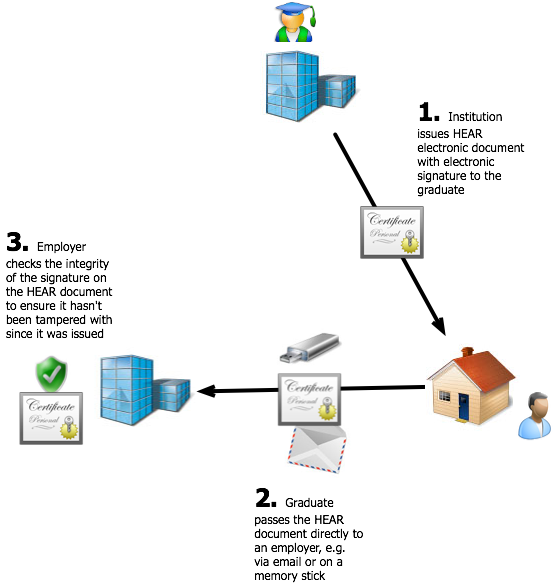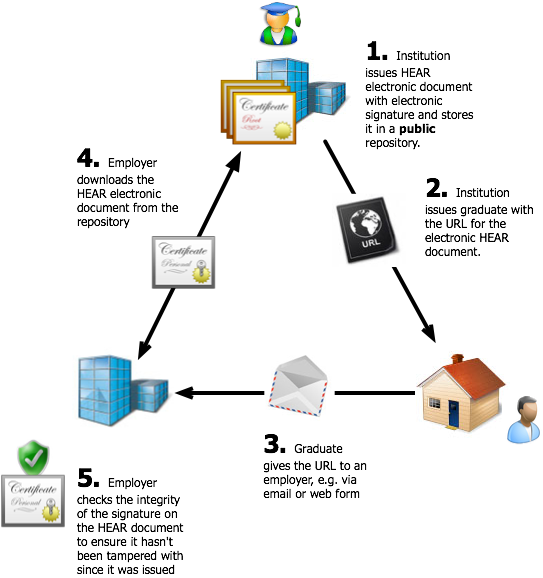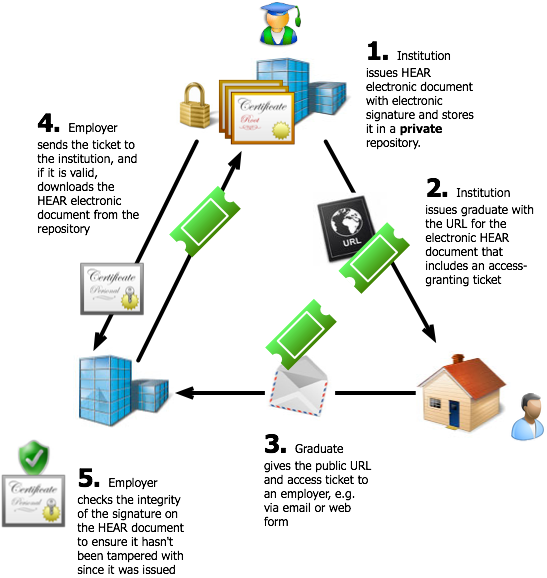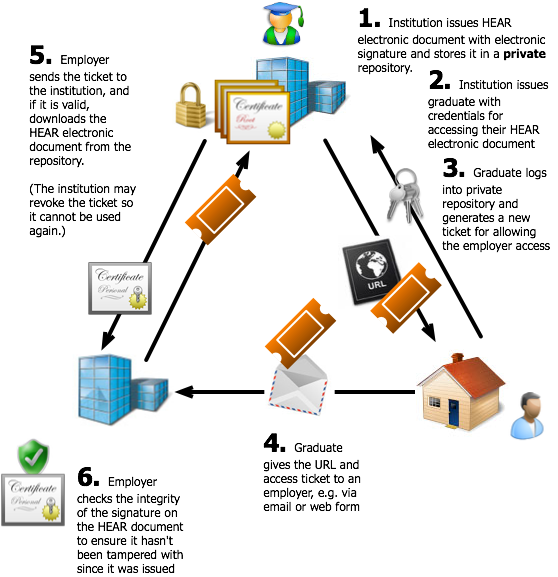hear
Technical architecture considerations for implementing the HEAR
About this page
This page was created as part of a series of consultations CETIS provided to the Burgess Implementation Steering Group for the UK Higher Education Achievement Report in 2009.
Terms of Reference
This is a draft for discussion produced by JISC CETIS on behalf of JISC for the HEAR implementation projects. Its content is non-normative and for discussion.
Terms Used In This Document
- Relying Party: An organisation that is the recipient of the HEAR and may wish to verify it; typically an employer or another HEI
- Issuing Institution: The institution that issues a HEAR
- Electronic Signature: A signature in digital form carrying legal authority.
- Digital Signature: A cryptographic method that enables the recipient of a document to determine the sender, and whether its contents have been altered since it was signed.
Overview
In this section we provide recommendations for the exchange of achievement data, including access and verification considerations.
Sharing Mechanisms for HEAR documents
In this report we present five models for distributing and verifying electronic HEAR documents. These models are to some extent complementary and choice of a particular model over another does not present a significant interoperability issue for employers or other third parties. Instead institutions and vendors should consider the pros and cons of each approach in terms of feasibility and desirability from a business viewpoint.
Type 1: Standalone Document Model
In this model the HEAR electronic document is created and signed by the issuing institution, and then passed onto the graduate. The graduate may then pass their HEAR to relying parties, who can verify whether the document has been tampered with since it was issued by examining the digital signature.

Type 2: Public Online Document Model
In this model the HEAR electronic document is created and signed by the issuing institution, but rather than passing it directly to the graduate it retains the HEAR as a publicly-downloadable electronic document. The graduate is issued with the URL for downloading their HEAR, which they can pass onto employers or other relying parties. The replying party can use the URL to download the HEAR for an applicant, and verify the document signature as before.
Note that this model does not also preclude the Type 1 model, as the graduate themselves may choose to download and directly distribute the document.

Type 3: Ticket Release Model
In this model the HEAR electronic document is created and signed by the issuing institution, and maintained within a protected repository. The graduate is issued with the URL for accessing their HEAR, which also has a parameter containing a unique ticket that grants access to the document. As in the Type 2 scenario, the graduate can pass on the URL and ticket to a relying party to enable them to access, download, and verify the HEAR. The difference in this scenario is that without a valid ticket, each of which is keyed to a specific HEAR document, access to HEAR documents is denied.

Note that the URL and access ticket may in fact take the form of a standard link containing a parameter, e.g.:
https://www.easthampton.ac.uk/hear/1234567890?ticket=12321abc234234efff324234223abcd
It requires no special software or configuration to be used by the relying party to make use of this architecture.
Type 4: Limited-Use Ticket Release Model
In this model the HEAR electronic document is created and signed by the issuing institution, and maintained within a protected repository. The graduate is issued with credentials (typically a username and password) for accessing an extranet at the issuing institution (or outsourced service provider). When the graduate wishes to grant access to their HEAR to an employer or other relying party, they must login to the extranet with their credentials, and generate a new ticket that will grant limited access. The ticket and URL are sent to the relying party (or the graduate can copy this information into an email they send themselves), and the relying party can then use the ticket to access, download, and verify the HEAR.
After downloading, the ticket may be revoked by the service to prevent its further use; similarly, a ticket may be issued with a use-by date and be automatically revoked when this has expired. Also, users may be able to control access to a document independently of any ticket-specific mechanisms; this is discussed further in the section on security considerations.
Depending on requirements the relying party may need to register and login to make use of the service, in addition to possessing a valid ticket.

Type 5: Document Share Model
In this model the HEAR electronic document is created and signed by the issuing institution, and maintained within a protected repository. The graduate is issued with credentials (typically a username and password) for accessing an extranet at the issuing institution (or outsourced service provider). When the graduate wishes to grant access to their HEAR to an employer or other relying party, they must login to the extranet with their credentials, and generate a new ticket that will grant limited access to the extranet for the relying party. The ticket and URL are sent to the relying party (or the graduate can copy this information into an email they send themselves), and the relying party can then use the ticket to access online (but not download) the HEAR. After accessing the extranet, the ticket may be revoked by the service to prevent its further use; similarly, a ticket may be issued with a use-by date and be automatically revoked when this has expired.
Depending on requirements the relying party may need to register and login to make use of the service, in addition to possessing a valid ticket.
The primary difference between Type 4 and Type 5 systems is that the Type 5 system does not share any physical documents, but instead offers online access rather like Google Docs.

Multiple models
It is entirely appropriate to offer multiple models of access and verification, for example both Type 1 and Type 2, or Type 5 and Type 1, particularly where the HEAR itself comprises multiple digital artefacts with different requirements for access and verification. This is discussed further in the section below on composite access and verification requirements.
\
Privacy and Security Considerations
The nature of verification and access control depends on several key decisions that institutions make:
- What the HEAR record contains. If this includes sensitive personal information in addition to public statements, then this will require access management.
- The business model that underpins the use of the HEAR. For example, whether the issuing institution engages in a partnership with recruitment agencies, or has a fee charging model for verification.
The questions of the content of the records and the nature of the business model should be explored by projects and determined by issuing institutions; it is not determined by the technical architecture, but has a very important impact on the choices available.
Signing and Verifying HEAR documents
For the electronic HEAR to have long-term legal validity and be capable of being verified, it must:
- use an electronic signature conforming to a recognised standard
- use a recognised standard timestamp, ensuring that the document was signed at a particular date and time
- be able to be periodically re-stamped (notarised) to ensure long-term validity
We recommend that implementations conform to the European Telecommunications Standards Institute (ETSI) standards for Advanced Electronic Signatures. These standards build upon the W3C XML Digital Signatures specification, and are recognised under European Union Directive 1999/93/EC.
Tamperproofing
If an electronic hear is signed using a digital signature, then the resulting document is tamper-evident; that is, if any amendments are made to the document after it is signed, then this will be evident when evaluating the signature. Electronic signatures conforming to the AES standards, as discussed in the previous section, have this capability.
Access Control
If the HEAR needs access control, this can be for reasons of privacy or for business purposes. In either case, there is always a tradeoff to be made between the degree and cost of security, and the value of the target. If the value of the target can be reduced (for example, referencing other more secure information rather than replicating it in the document) then the degree and cost of security can be reduced. However, if the HEAR includes replicated sensitive personal information this increases the document value and requires more costly security procedures.
If access control by the subject is required, the issues are then raised of how credentials are issued, and how individuals are verified. Account management can be a significant cost, for example supporting retrieving lost credentials, account revocation, and monitoring suspicious access patterns. However, individual access control also enables individuals to control access to their information in more sophisticated and convenient ways; for example, closing down access to all their documents t third parties after accepting a job offer.
Again, this is a topic that needs consideration by implementers from a business as well as a technical point of view.
Composite privacy, verification and access requirements
The complete set of achievement information for any graduate spans multiple levels of privacy and sensitivity. For implementers this raises the question of how to address these different levels of concern in the system architecture.
One approach is to divide the parts of the achievement information into separate electronic documents, each of which can be handled by a mechanism that implements an appropriate access and verification mechanism; for example, the diploma on its own may be a publicly downloadable document using a simple Type 1 architecture, whereas the transcript uses a Type 5 architecture, and additional personal information uses Type 5 access control but without a verification stamp. This is the simplest to implement, and requires only that each part can be addressible in terms of policy (e.g. separately identifiable diploma and transcript objects rather than a single monolithic report).
A more complex approach is to use a policy-combining algorithm to determine access based on the parts being requested. This requires that not only are parts identified, but also that the policies governing the parts can be expressed using a standard language, and combined within a single policy decision and enforcement system. The XACML specification is designed with this in mind, but is a very complex system to implement and may be beyond the capabilities of many issuing institutions to manage and maintain.
Safeguarding tickets from eavesdropping and replay attacks
If tickets are sent to the repository over a standard HTTP connection there is always the possibility that the traffic can be intercepted and the request replayed at a later date by a third party. To prevent this the repository implementation may:
- Issue single-use tickets under the Type 4/5 scenario
- Only conduct transactions using TLS encryption (HTTPS)
- Both of the above
Falsifying providers
It is entirely feasible for an individual to setup a fake university website implementing the architecture described in this document, and then sign their own made-up HEAR electronic documents to distribute to other parties. The only protection against this is to inspect the issuing authority of the HEAR and verify it as a trusted education provider. A simple mechanism is to check the web address – for example, that the HEAR is coming from
https://www.easthampton.ac.uk
and not something along the lines of:
http://www.easthampton-ac-uk.com/
Another approach is to make use of a trusted source of institutional information, such as the UK Register of Learning Providers (http://www.ukrlp.co.uk/). If a HEAR document contains a UK Provider Reference Number (UKPRN) then this can be cross-checked to ensure that the document is signed using a key from the registered internet domain of that provider and not from another source, or in a Type 5 architecture that the extranet the relying party is visiting matches the entry in the UK RLP.
Finally, if the mechanism for sharing the URL for accessing the HEAR is under the control of the Institution, then they may use a digitally signed email, which can be used to verify that the URL was sent from an authorised address.
In all these cases the issuing institution MUST manage its TLS signing keys effectively.
Avoiding Guessable tickets
Implementations using a Type 3/4/5 architecture should ensure that they act to prevent other parties guessing a correct URL-ticket combination. Implementation may use one or more of the following strategies:
- Monitor traffic and shut out IP addresses that appear to be attempting brute-force cracking of the system
- When generating tickets include a nonce value generated using a high-quality random number algorithm
- Use an appropriate ticket length to increase the search space that a party would need to attack
Stolen Tickets
It is possible that under a Type 3/4/5 architecture that a graduate may have their ticket stolen in some fashion; for example, leaving it on a USB drive, accidentally disclosing it online, etc. In such cases implementations may want to restrict the extent to which stolen tickets can be used to access documents. A number of strategies can be considered:
- Under a Type 4/5 system, the identity of the relying party may be encoded in the ticket itself, so that the repository can check whether the request originates in the same domain as the ticket.
- If a graduate suspects they have lost or disclosed their ticket, the system may provide a means of for them to request revocation of the ticket. This is particularly relevant in a Type 2 architecture, where use of a single ticket is unlimited.
- Tickets under a Type 4/5 system may be time-limited and expire automatically, reducing the window of opportunity for using a stolen ticket.
Auditing
Implementations using a Type 3/4/5 architecture should as a matter of best practice record the use of tickets to access HEAR documents for auditing purposes. Tickets that are revoked or expired, and the access logs based on those tickets, should also be retained for auditing.
Deployment Considerations
Depending on the cost and complexity of the solution required, issuing institutions may wish to consider external hosting arrangements with specialist service providers, or to combine with other issuing institutions to share a common solution (i.e., a shared service). There is no reason in principle not to do this; the key issues to be considered in such cases are the governance, cost, business case, and legal implications.
For example, the models described above can apply to:
- A single institution using a locally hosted and managed repository and service portal
- A federation of institutions (such as GMSA, SURF or a LLN) sharing a single repository and portal
- A federation of institutions sharing a single portal and access solution, but individual repositories
- A national shared repository and portal service
Other implementation guidance
Protocols
The core document access service, and especially the document access URLs and tickets, should be developed using the standard web protocols, HTTP and HTTPS (HTTP with Transport Layer Security, TLS).
Additional protocol layers, such as SOAP/WSDL are not recommended for the outward-facing services as they increase implementation costs and minimum technical requirements for both the issuing institution and relying parties.
However, a solution may use Service-Oriented Architecture and more complex specifications in its implementation, typically for internally-facing services.
Identifiers & URLs
Where URLs or identifiers are used in any part of the HEAR, these should be issued and maintained with a policy of long-term management. Once a URL or identifier is encoded in a HEAR then that URL is being stamped and verified by the institution as a valid identifier or reference; this means that institutions MUST maintain those URLs for the lifetime of the HEAR, and in particular identifiers and URLs MUST NOT be reallocated to other resources.
Partial versus whole records
It may be useful for implementers to offer services (web APIs) that expose partial rather than complete HEAR records, execute queries, or aggregate reports from multiple HEARs. This can form a value-added service for partner organisations, for example.
In general such services should be designed with the same security and privacy considerations as complete HEAR records; wherever possible sensitive information should not be shared using such services, unless the issuing institution is willing and capable of implementing the necessary systems, policies and procedures.